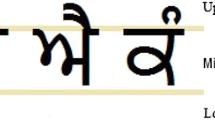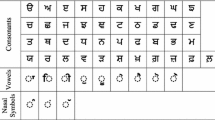Abstract
In this paper, we have proposed Support Vector Machine (SVM) based efficient algorithm for Gurmukhi akshara formation/recognition. To train SVM classifier, a specific training data set has been used that forms an initial base to classify it. Experiment results have been obtained by using the software LibSVM where after preprocessing, coordinates were scaled from1 to 9 using the tool of LibSVM. In this experiment, 46,772 words were initially collected. In these words, 2,47,697 strokes were identified and further annotated. We tested the proposed methodology on 4,310 samples of Gurmukhi aksharas collected from different users. Testing results clearly reveal that for different combinations of Gurmukhi strokes and vowel/nasal, a high degree of accuracy has been achieved.

Similar content being viewed by others
References
Jain AK, Duin RPW, Jianchang M (2000) Statistical pattern recognition: a review. IEEE Trans Pattern Anal Mach Intell 22(1):4–37
Plamondon R, Srihari SN (2000) On-line and off-line handwritten character recognition: a comprehensive survey. IEEE Trans Pattern Anal Mach Intell 22(1):63–84
Arica N, Yarman-Vural FT (2001) An overview of character recognition focused on off-line handwriting. IEEE Trans Syst Man Cybern Part C Appl Rev 31(2):216–233
Lorigo LM, Govindaraju V (2006) Offline Arabic handwriting recognition: a survey. IEEE Trans Pattern Anal Mach Intell 28(5):712–724
Nagy G (1998) Chinese character recognition: a twenty five year retrospective. Int Conf Pattern Recognit: 163–167
Prasad JR, Kulkarni UV (2014) Gujrati character recognition using adaptive neuro fuzzy classifier. Int Conf Electron Syst Signal Process Comput Tech: 402–407
Sazal MMR, Biswas SK, Amin MF, Murase K (2014) Bangla handwritten character recognition using deep belief network. Int Conf Electr Info Commun Tech: 1–5
Manikandan BJ, Shankar G, Anoop V, Datta A, Chakravarthy VS (2002) LEKHAK: a system for online recognition of handwritten Tamil characters. Int Conf Nat Lang Process: 29–36
Sharma A, Kumar R, Sharma RK (2009) Rearrangement of recognized strokes in online handwritten Gurmukhi word recognition. 10th Int Conf Doc Anal Recognit: 1241–1245
Arora Sandhya et al (2010) Performance comparison of SVM and ANN for handwritten Devanagari character recognition. IJCSI Int J Comput Sci Issues 7(3):18–26
Jawahar CV, Kumar P, Kiran MNSSK, Ravi SS (2003) A Bilingual OCR for Hindi-Telugu documents and its applications. Seventh Int Conf Doc Anal Recognit: 408–412
Pal U, Tetsushi SC, Wakabayashi, Kimura F (2008) Accuracy improvement of Devanagari character recognition combining SVM and MQDF. 11th Int Conf Front Handwrit Recognit: 367–372
Kumar R, Sharma RK (2013) An efficient post processing algorithm for online handwriting Gurmukhi character recognition using set theory. Int J Pattern Recognit Artif Intell 7(4): 1353002-1-17
Madhvanath S, Kim G, Govindaraju V (1999) Chaincode contour processing for handwritten word recognition. IEEE Trans Pattern Anal Mach Intell 21:928–932
Slavik P, Govindaraju V (2001) Equivalence of different methods for slant and skew corrections in word recognition applications. IEEE Trans Pattern Anal Mach Intell 23(3):323–326
Vapnik VN (1999) The nature of statistical learning theory. Springer, Verlag
Christopher JCB (1998) A tutorial on support vector machines for pattern recognition. Data Min Knowl Disc 2(2):121–167
Vapnik VN (1998) Statistical Learning Theory. John Wiley & Sons, New York
Chang CC, Lin CJ (2011) LIBSVM: a library for support vector machines. ACM Transactions on Intelligent Systems and Technology 2(3): 1–27. Software available at http://www.csie.ntu.edu.tw/~cjlin/libsvm
Acknowledgments
We take this opportunity to thank Technology Development for Indian Languages (TDIL), DeitY, MoCIT, and Government of India for sponsoring the data collection used in this work.
Author information
Authors and Affiliations
Corresponding author
Rights and permissions
About this article
Cite this article
Kumar, R., Sharma, R.K. & Sharma, A. Recognition of Multi-Stroke Based Online Handwritten Gurmukhi Aksharas. Proc. Natl. Acad. Sci., India, Sect. A Phys. Sci. 85, 159–168 (2015). https://doi.org/10.1007/s40010-014-0183-z
Received:
Revised:
Accepted:
Published:
Issue Date:
DOI: https://doi.org/10.1007/s40010-014-0183-z




